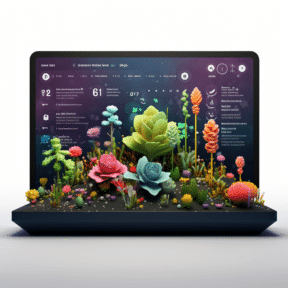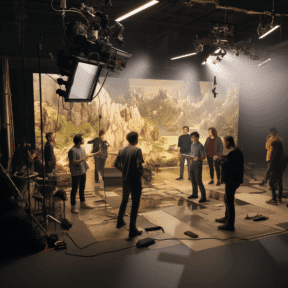Why should we care?
Let’s break it down.
Video marketing isn’t just another passing trend; it’s a powerful strategy that resonates with today’s tech-savvy consumers on another level.
It gives us an opportunity to tell our stories more vividly, connect emotionally with our audience and ultimately drive action like no other medium can.
So if you’ve been looking for ways to liberate your brand from the shackles of traditional marketing methods, buckle up!
You’re about to discover why implementing video content into your strategy is a game-changer.
Key Takeaways
– VR has the potential to create immersive and engaging experiences for content creators.
– AI-driven content can revolutionize video creation and delivery.
– Machine learning and AI technologies are advancing rapidly.
– AI can analyze user behavior and preferences to generate personalized video content, eliminating generic mass-market ads.
Understanding the Rise of Visual Content

You’ve got to understand, folks, the rise of visual content isn’t just a trend—it’s completely revolutionizing the game in today’s digital world.
We’re living in an era where visual literacy development matters more than ever before.
The constant stream of images and videos flooding our screens daily has made it crucial for us to efficiently interpret and comprehend visual information.
This rapid shift towards visuals hasn’t just changed how we communicate with each other; it’s altering how businesses need to interact with their audience too.
So, if you’re not hopping onto this bandwagon yet, you’re undoubtedly missing out on a massive opportunity.
The profound impact on SEO is another critical aspect that can’t be overlooked when discussing the importance of video marketing.
By incorporating quality videos into your marketing strategy, we’re telling you, your website’s organic traffic will significantly increase, improving your search engine rankings like never before!
We’re talking about better engagement rates, increased dwell time on site— all leading to improved visibility online.
And who doesn’t want more eyes on their brand?
Now that we’ve put forth why the rise of visual content is so consequential for businesses today, let’s delve deeper into how using videos specifically could elevate your marketing strategy even further.
Benefits of Implementing Videos in Your Strategy

Incorporating visuals into your plan can skyrocket your engagement rates, making it a powerful tool to connect with your audience on a deeper level. Videos offer an immersive experience that static content simply can’t match. They have the potential to make complex information more digestible and engaging for viewers, which is why they’ve become a game changer in today’s digital world. We’re not just talking about ordinary videos though; we mean well-crafted, strategically executed, and SEO-optimized ones.
There are numerous benefits to implementing videos in your marketing strategy:
1. **Video SEO Optimization**: When properly optimized for SEO, videos can significantly improve your search engine rankings. This means more visibility and traffic for your website or platform.
2. **Increased Engagement**: Videos captivate people’s attention better than any other form of content out there. They’re interactive and entertaining, encouraging viewers to stay longer on your site or social media page.
3. **Viral Video Potential**: If done right, videos have the power to go viral — spreading rapidly and widely from one user to another — thus increasing brand awareness exponentially.
Remember: the goal here isn’t just about churning out video after video but creating meaningful content that resonates with your audience while effectively communicating what you stand for as a brand or organization.
Now that we’ve outlined why incorporating video is crucial, let’s turn our focus towards crafting captivating visuals that will capture hearts and minds alike.
Tips for Creating Engaging Video Content
Crafting engaging visuals that captivate your audience requires careful planning and execution, so let’s dive into some tips that’ll help your content shine.
The first step starts with harnessing storyboarding techniques. This method allows us to map out our ideas visually, giving us a clear vision of what our final product should look like. It’s crucial for us to ensure each scene contributes effectively to the overall narrative and keeps our viewers hooked.
Next, we need to consider the power of video editing software. This isn’t just about cutting and trimming clips; it’s about weaving together an engaging story, integrating captivating audio, adding effects that enhance the mood, and adjusting color grades to make visuals pop.
As we master these elements, we’re not only creating videos – we’re crafting experiences that resonate with our audience on a deeper level. We’re liberating them from mundane content, offering them something more stimulating and rewarding in return for their attention.
Remember: in today’s digital world where attention spans are shorter than ever, every second of your video needs to count!
But how do you know if all this hard work is paying off? Well, after putting these tips into action and pushing out your video campaigns into the wild world of internet marketing, it becomes vital to gauge their effectiveness by measuring their success rate – which happens to be our next focus area.
Measuring the Success of Your Video Campaigns
Assessing the impact of your meticulously designed visual campaigns is no simple feat, yet it’s an integral aspect of mastering this art form. We need to be aware that video marketing doesn’t end after hitting the ‘publish’ button – far from it! It’s about understanding how our content translates into real-world results and drawing insights from that. This is where Campaign Analytics come in; they enable us to measure our success and identify areas for improvement by providing detailed data on viewer interaction, engagement levels, audience demographics, and much more.
When we talk about measuring success, we’re not just talking about getting high views or likes; it’s a lot deeper than that. The true measure lies in knowing whether our content has reached its Target Audience and if it has managed to resonate with them effectively. To do this accurately, we need to delve into analytics such as view duration rates, click-through rates (CTR), social sharing stats among others. Here’s a table that sums up some crucial metrics:
| Key Metrics | Why It’s Important |
|————-|——————-|
| View Duration | Gives insight into how engaging your content is |
| Click-Through Rate (CTR) | Helps understand if your CTA is effective |
| Social Sharing Stats | Indicates popularity & reach of your content |
This ongoing process of creating video content, analyzing performance data, refining strategies based on those analyses – isn’t just savvy marketing; it offers us a kind of liberation – the ability to continuously improve and adapt in an ever-changing digital landscape. As we move forward let’s keep exploring what’s around the corner for us — especially future trends in the world of video content creation.
Future Trends in the World of Video Content Creation

Peeking into tomorrow’s horizon, we’re bound to witness an exciting evolution in how content is created and consumed. The advent of Virtual Reality (VR) usage has opened up a whole new dimension in video marketing. Imagine being able to engage your audience not just on their screens, but by immersing them into a virtual world where they can interact with your brand in ways previously unimaginable. This is the power that VR holds for future content creators, enabling us to craft experiences that are more engaging, immersive, and ultimately persuasive.
Furthermore, let’s not forget the growing potential of AI-driven content. With strides being made in machine learning and artificial intelligence technologies every day, it won’t be long before these advancements revolutionize how we create and deliver video content. AI could potentially analyze user behavior and preferences at scale to help us generate personalized video content tailored to each individual viewer’s needs. Picture this – no more generic mass-market ads; instead, everyone gets a unique marketing message designed just for them!
We’re standing on the brink of something truly liberating – the future of video marketing beckons us all towards greater creativity and personal freedom.
Conclusion
We’ve seen how video marketing has revolutionized the digital space. It’s clear that incorporating videos into our strategy is no longer optional, it’s a must.
Engaging video content can boost brand visibility, and when done right, can bring impressive results.
The future of digital marketing is dynamic and ever-evolving. As we continue to adapt and innovate in our strategies, let’s not forget to measure the success of our campaigns. After all, what gets measured gets managed!


